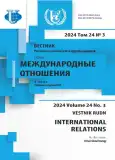Myanmar’s Role in China’s Belt and Road Initiative
- 作者: Mosyakov D.V.1, Shpakovskaya M.A.2, Ponka T.I.2
-
隶属关系:
- Institute of Oriental Studies, RAS
- RUDN University
- 期: 卷 24, 编号 3 (2024): China’s Global Strategy
- 页面: 439-449
- 栏目: 双方关系
- URL: https://journal-vniispk.ru/2313-0660/article/view/320696
- DOI: https://doi.org/10.22363/2313-0660-2024-24-3-439-449
- EDN: https://elibrary.ru/YSYTJA
- ID: 320696
如何引用文章
详细
This study examines the importance of Myanmar for the formation of a Sino-centric macro-region through the Belt and Road Initiative (BRI). The authors rely on the transit of power theory that helps to analyze systemic imperatives and internal characteristics of China’s foreign policy. The authors applied the principles of historicism, scientific objectivity and reliability. In the first part of the work, the Chinese Belt and Road initiative is studied as a geostrategic tool of the People’s Republic of China (PRC). The authors consider the features of its development and the strategic results of its implementation. In particular, the article emphasizes that this initiative is aimed at the formation of a Sino-centric macro-regional space. Based on this, the role of Myanmar is characterized as essential. The geographical location of this state allows China to gain access to the Indian Ocean, a transit region for energy resources, as well as to overcome one of the strategic vulnerabilities of its geopolitical position - the ‘Malacca dilemma.’ Moreover, as a border state, Myanmar is an indispensable link in the implementation of land and gas energy transport corridors of macro-regional importance. Finally, in the context of strategic competition between the United States and China, the importance of ensuring stability in critical proximity to the PRC’s state borders is growing, especially in the absence of a stable internal state situation in Myanmar. Among the additional factors, the authors highlight the importance of the mood of state and local elites for the development of this initiative. In this regard, the analysis of China’s reaction to the military coup in Myanmar in February 2021 was particularly indicative that Myanmar is of key importance because of its strategic location between China and the Indian Ocean, as well as its resource potential.
作者简介
Dmitry Mosyakov
Institute of Oriental Studies, RAS
编辑信件的主要联系方式.
Email: mosyakov.d@gmail.com
ORCID iD: 0000-0003-2701-3533
SPIN 代码: 5707-5500
Dr. of Sc. (History), Professor, Head, the Center for the Study of Southeast Asia, Australia and Oceania
Moscow, Russian FederationMarina Shpakovskaya
RUDN University
Email: shpakovskaya-ma@rudn.ru
ORCID iD: 0000-0003-4463-880X
SPIN 代码: 5857-3760
Dr. of Sc. (History), Professor, Department of Theory and History of International Relations
Moscow, Russian FederationTatiana Ponka
RUDN University
Email: ponka-ti@rudn.ru
ORCID iD: 0000-0003-4944-115X
SPIN 代码: 5858-3578
PhD (History), Associate Professor, Department of Theory and History of International Relations
Moscow, Russian Federation参考
- Ahamed, A., Rahman, M. S., & Hossain, N. (2020). China - Myanmar bilateral relations: An analytical study of some geostrategic and economic issues. Journal of Public Administration and Governance, 10(3), 321-343. https://doi.org/10.5296/jpag.v10i3.17704
- Ananiin, M. A. (2013). Internal policy of an independent state, and the strategic interests of world powers (the experience of Myanmar). Outlines of Global Transformations: Politics, Economics, Law, 6(4), 118-128. (In Russian). EDN: ROXWIF
- Bogaturov, A. D. (1996). Pluralistic unipolarity and Russia’s interests. Svobodnaya Mysl’, (2), 24-36. (In Russian). EDN: WCAPKZ
- Degterev, D. A., Ramich, M. S., & Tsvyk, A. V. (2021). U.S. - China: “Power transition” and the outlines of “conflict bipolarity”. Vestnik RUDN. International Relations, 21(2), 210-231. https://doi.org/10.22363/2313-0660-2021-21-2-210-231; EDN: PXYZEE
- Gong, Xue. (2020). Understanding the Belt and Road Initiative in Myanmar: A socio-politico and economic approach. China and the World, 3(4), 2050016. https://doi.org/10.1142/S2591729320500169
- Kobayashi, Y., & King, J. (2022). Myanmar’s strategy in the China - Myanmar Economic Corridor: A failure in hedging? International Affairs, 98(3), 1013-1032. https://doi.org/10.1093/ia/iiac049
- Latt, L. Ch. (2022). China’s involvement in Myanmar’s peace negotiations: An analysis with special emphasis on the non-interference principle. Journal of the Asia - Japan Research Institute of Ritsumeikan University, 4, 85-107. https://doi.org/10.34389/asiajapan.4.0_85
- Layne, Ch. (2012). This time it’s real: The end of unipolarity and the Pax Americana. International Studies Quarterly, 56(1), 206-213. https://doi.org/10.1111/j.1468-2478.2011.00704.x
- Lebedeva, N. B. (2010). Triangle “India - Myanmar - China” (problems and compromises of interaction). South East Asia: Actual Problems of Development, (15), 46-78. (In Russian). EDN: NULFNH
- Maung, M. (2011). In the name of Pauk-Phaw: Myanmar’s China policy since 1948. Singapore: Institute of Southeast Asian Studies.
- Namzhilova, V. O. (2018). Economic corridors in Eurasia: China’s initiatives and world experience. Russia and the Pacific, (1), 65-81. (In Russian). EDN: YWJEZN
- Organski, A. F. K. (1958). World politics. New York: A. Knopf.
- Roy, C. (2022). China’s grand strategy and Myanmar’s peace process. International Relations of the Asia-Pacific, 22(1), 69-99. https://doi.org/10.1093/irap/lcaa012
- Sigit, S., Setiawan, T. J., & Bachtiar, J. W. (2022). Myanmar’s dilemma in the United States - China rivalry in Southeast Asia. Malaysian Journal of International Relations, 10(1), 79-93. Retrieved from https://mjir.um.edu.my/index.php/mjir/article/view/36638
- Simoniya, A. A. (2017). China’s role in Myanmar’s national peace process. South East Asia: Actual Problems of Development, (34), 171-187. (In Russian). EDN: ZELRTX
- Singh, S. (2016). Rebuilding lifelines of its soft under belly: China engages its southwest frontiers. In T. Fingar (Ed.), The new great game: China and South and Central Asia in the era of reform (pp. 147-179). Stanford, CA: Stanford University Press. https://doi.org/10.1515/9780804797641-011
- Skidmore, M., & Wilson, T. (Eds.). (2008). Dictatorship, disorder and decline in Myanmar. Canberra: ANU Press. http://doi.org/10.22459/DDDM.12.2008
- Vinogradov, A. V. (2021). “Unipolar Asia”: Chinese regional order. World Economy and International Relations, 65(3), 23-32. (In Russian). https://doi.org/10.20542/0131-2227-2021-65-3-23-32; EDN: CTWDQV
- Volosyuk, O. V., & Phyo Naing, W. Ya. (2019). The expansion of Chinese business in Myanmar and Sino-Myanmar relations (1988-1990). RUDN Journal of World History, 11(4), 305-314. https://doi.org/10.22363/2312-8127-2019-11-4-305-314; EDN: SEXXTL
- Wai, Ya. Ph. N. (2020). The dilemma of Sino-Myanmar relations: The case of Myitsone hydropower dam project. South East Asia: Actual Problems of Development, 1(1), 379-389. https://doi.org/10.31696/2072-8271-2020-1-1-46-379-389; EDN: QFNFWW
补充文件









